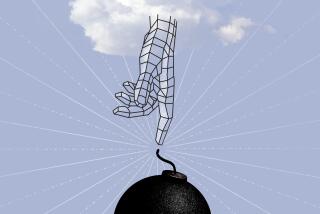Book review: ‘The Most Powerful Idea in the World’ by William Rosen
- Share via
The Most Powerful Idea in the World
A Story of Steam, Industry, and Invention
William Rosen
Random House: 372 pp., $28
A young Steampunk’s dream, William Rosen’s “The Most Powerful Idea in the World” manages to make sense of the many threads that together tell the story of the origins and applications of steam power. The book has a crackling energy to it, often as riveting as it is educational. Rosen, in pursuit of evidence, makes interesting, even exciting, such subjects as patent law from the Roman Tiberius on, technological innovation in ancient China and the role of practice in separating out accomplished performers from the “merely good.” If Rosen at times seems too hell-bent on single-minded pursuit of his enthusiasms, at least that’s better than a dull book.
Rosen’s central thesis is that the Industrial Revolution started specifically in Britain, despite a number of false starts elsewhere, due not just to a wealth of the necessary raw materials — a situation found elsewhere in the world — but also to such factors as a change from a patronage system for inventors to one that recognized intellectual property rights. Rosen further argues that the steam engine was “the signature gadget of the Industrial Revolution.” Why? “Its central position connecting the era’s technological and economic innovations: the hubs through which the spokes of coal, iron, and cotton were linked.”
Rosen’s exploration of the topic, starting with a loving and detailed description of Rocket (1829), “the machine that inaugurated the age of steam locomotion,” has a logical progression that’s hard to refute — explored in chapters with titles like “The Whole Thing Was Arranged in My Mind: Concerning the surprising contents of a Ladies Diary; invention by natural selection; the Flynn Effect; neuronal avalanches; the critical distinction between invention and innovation; and the merits of strolling on Glasgow Green.” The playfulness and invention evident in these descriptions carry over into chapters rich in detail and imbued with a sparkling intelligence. (For personal reasons, one of my favorite sections concerns “the unlikely contribution of the brewing of beer to the forging of iron.”)
Although Rosen does focus on general trends and societal factors related to the Industrial Revolution, he also gives the reader excellent thumbnail portraits of many scientists, engineers and inventors. Even those who aren’t household names today get props — like machine-tool specialist Henry Maudslay, creator of an accurate micrometer, a device for “measuring very small increments,” of whom Rosen writes, almost in stunned awe, “And still he remained obsessed with screws and screw-making machinery.”
Most Steampunks, other than the steam-drunk engineers at the Kinetic Steam Works in San Francisco, probably know an individual like Lord Kelvin — the physicist who pioneered breakthroughs in thermodynamics but also famously said “Heavier-than-air flying machines are impossible” — from the James Blaylock seminal Steampunk story “Lord Kelvin’s Machine.”
Mention the name “Arkwright” and you might get back a reference to the graphic novel “The Adventures of Luther Arkwright” by Bryan Talbot rather than to Richard Arkwright, inventor of the cotton spinning machine. The growing Steampunk subculture has absorbed a certain amount of fact about such historical figures but also mythologized them in a variety of fictional and role-playing contexts. From that perspective, it’s interesting to see people stripped of their current (unlikely) pop-culture romanticism.
“The Most Powerful Idea in the World” doesn’t pretend to be about the effects of industrialization, but Rosen does at least mention the trade-offs made to sustain the Industrial Revolution and its steam engines. Even today, the most direct human price comes from coal mining, which has resulted in a great deal of misery. In addition to contributing to climate change, other environmental costs are also quite high — one has only to read of various ecosystem degradations in the Appalachian region of the United States to understand that coal isn’t clean, and that therefore steam isn’t clean.
“Perpetual technological innovation is so much a part of contemporary life that it is difficult even to imagine the world without it,” Rosen writes, but maybe we should start to try to imagine it. A modern-day Steampunk might well say that perpetual innovation without reference to a sustainable future is a form of madness. (Reclaiming retro-technology for the Green Movement is one aspect of the Steampunk movement.)
Rosen writes that the lessons of the first decades of industrialization aren’t “what either side of the global warming debate would probably endorse” because the United States, for example, can afford to “convert to wind, water, and solar power” while many other countries can’t afford these higher-cost options. He may be right in the implied assertion that only further invention can improve our current situation, but I don’t believe him when he writes that the bulk of his book is, in part, “an attempt to demonstrate how the inventions created the crisis.”
“Lincoln,” Rosen writes, “had a long and passionate love for all things mechanical.” So too does Rosen. At its core, “The Most Powerful Idea in the World” is about the author’s passionate love for the intricacies of invention and applied science.
VanderMeer is the co-author with S.J. Chambers of the forthcoming “Steampunk Bible” and co-editor with Ann VanderMeer of the fiction anthologies “Steampunk” and the forthcoming “Steampunk Reloaded.”


